I’m not sure whether my fascination with Helen Keller came from reading about her or seeing the museum first. My mother would have to confirm for me. Just knowing that Helen Keller grew up a town over from my parents sparked my interest. I read Helen Keller: Courage in the Dark by Johanna Hurwitz so many times that I practically had it memorized. Almost twenty years later, I want to see how Hurwitz’ book could combine with faith to inspire young readers.
The Helen Keller Museum
I don’t remember how old I was when my grandmother took me to the Helen Keller festival one summer. She drove me to a big, grassy field with a two-story house and side building. We walked through the house with its creaky wood floors. The sinking sun colored the rooms gold. We peered through the windows of the small side building where colorful wooden toys covered the ground. We meandered by the black iron water pump to chairs that faced the back of the main house. We watched a reenactment of Helen Keller’s early life, and I learned how to spell water in sign language.
Seeing Helen Keller’s home in real life inspired me to learn as much as I could about her. I loved reading and reading about all Helen learned and accomplished in her life. I imagine her writing abilities piqued my interest, too, since I always loved telling stories. Even now, reading Helen Keller: Courage in the Dark reminds me of all we can accomplish with hard work. The growth certainly comes with its challenges, but things I believed to be possible at 6 don’t have to be impossible now. The book truly inspires hope, which blends wonderfully with faith.
Faith in “Helen Keller: Courage in the Dark”

Just because early readers use simple language doesn’t mean that the concepts can’t be complex. In Helen Keller: Courage in the Dark, Hurwitz shows young readers the challenges Helen Keller faced as a blind and deaf young woman. Even thought the sentence structure repeats and the language is basic, Hurwitz beautifully chooses details that young readers can relate to. This way, the readers put themselves in Helen Keller’s shoes and learn compassion.
I also love that at the end of chapter 2, Hurwitz adds that Annie Sullivan considered Helen’s quick learning a “miracle.” Considering the time and place, Annie Sullivan’s statement probably was religious. Hurwitz blends it into the story seamlessly by showing how Helen’s behavior changed. Readers understand why Sullivan called it a miracle because they saw for themselves how different Helen’s life became.
